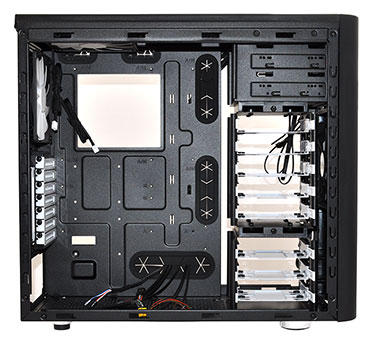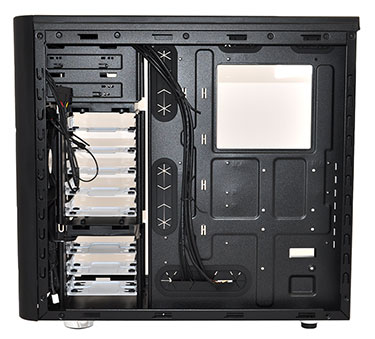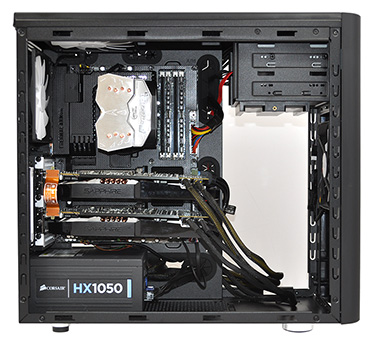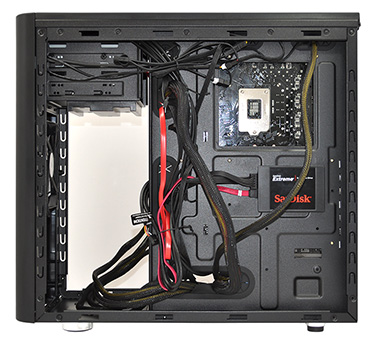Optimised For Rads
The Arc Midi R2 doesn't offer the most spacious interior, but the layout is logical and certain elements are particularly well thought out. As you'd expect, a well-sized cutout in the motherboard tray makes for simple CPU cooler installed, a couple of rubber-grommeted cable holes help maintain a tidy build, and the chassis' existing cables are neatly routed from top to bottom. Serving the needs of either new or old components, the front USB 3.0 ports can be connected to your choice of USB 2.0 or 3.0 headers.
Neither the optical drive bays nor hard-disk trays are tool free, but the latter do offer a good deal of customisation. Split across 5+3 cages, the upper cage can be rotated to presumably aid airflow, and if you to choose to use only the lower three-bay cage, it can be shuffled across to the left to open up room for a 240mm front radiator.
On the topic of cooling, Fractal includes a trio of Silent Series R2 fans as standard; a 140mm front intake; a 140mm rear exhaust and a 140mm top exhaust. All three can be hooked up to the integrated fan controller, but the built-in hub doesn't have any room for expansion so any additional fans will need to be attached to any available motherboard headers. Speaking of additional fans, there's a spare 120/140mm mount up front, a 120/140mm mount at the bottom, and another 120/140mm mount up top.
What's handy is that the chassis' top fan mounts are offset, making it relatively easy to install a 240mm radiator - even a thick radiator should fit well with the right motherboard. It's this liquid-cooling capability that sets the Arc Midi R2 apart from the sound-proofed Define R4. Whereas the latter is geared toward quiet operation, the Arc Midi favours performance potential and can conceivably house up to four radiators; 240mm up top; 240mm up front, 120mm at the bottom; 120mm at the back.
SSD-only builds that utilise the mounts on the back of the motherboard tray have the advantage of being able to remove both hard-disk cages, making the chassis feel roomier and easy to build into. In this configuration, there's plenty of room for a high-end pump or reservoir, though, if you are planning on using the rear 2.5in drive mounts, remember that your SSD has to be installed before your motherboard. Forgetting to do so can be frustrating, as we learnt first hand, and Fractal really should use slot-in 2.5in brackets that would allow drives to be swapped at any stage.
In other areas of the chassis we found little to dislike. The motherboard tray could have been stiffer - it has a tendency to flex under too much pressure - and a couple of pre-installed standoffs would have helped ease installation, but for the most part the Arc Midi R2 is easy to work with and serves up no real surprises. In keeping with most of Fractal's recent chassis, the frame is suitably wide, resulting in roughly an inch of free space behind the motherboard tray for excess cables.
There's room for CPU coolers standing up to 180mm tall, graphics cards measuring up to 430mm in length (or 290mm if you're intent on keeping the top drive cage), and large dust filters are in place to help keep components clean in the long run. The front filter, as mentioned, springs out with a gentle push, the bottom filter slides out from beneath the PSU, and the top of the chassis is essentially one large, foam-padded filter that comes away for cleaning after undoing a pair of thumbscrews.
Overall, we quite liked building into the Arc Midi R2. It is, for all intents and purposes, the Define R4 without the sound-proofing and with more room for radiators, and it reminds us why we like certain Fractal chassis; they're well put together, well organised and very easy going.













